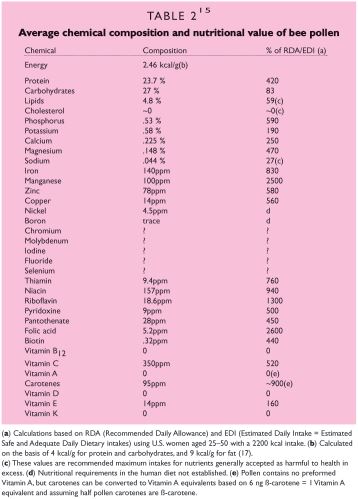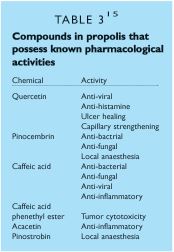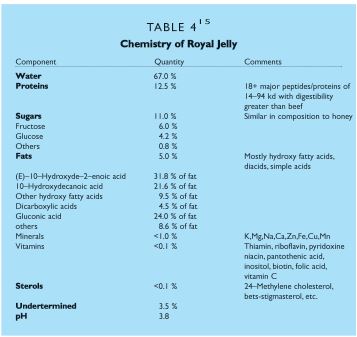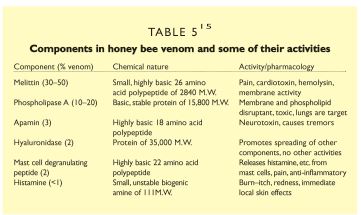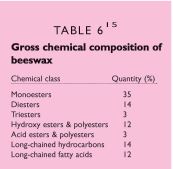Positive Health Online
Your Country

Bee Products, Properties and Applications
by Professor Avshalom Mizrahi(more info)
listed in nutraceuticals, originally published in issue 25 - February 1998
One of the most applicable groups of natural products, used by human beings from ancient times, are bee products. Honey bees are master chemists and chemical engineers. Their success in the animal kingdom is largely because of the chemistry and the applications of their products: honey, beeswax, bee venom, propolis, pollen, and royal jelly. Three of these products: beeswax, venom, and royal jelly, are chemically synthesised by the bees themselves. The other three (honey, propolis and pollen) are derived from plants and are modified and engineered by the bees for their own use.
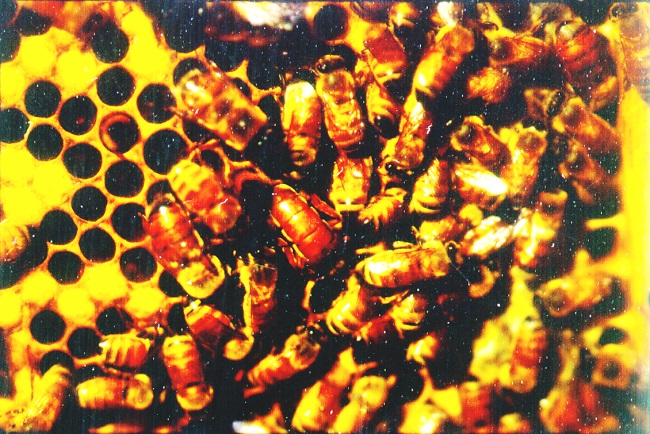
The use of these products explains the amazing honey bee success. Honey is used as a stable, reliable food source that serves during times of shortages, enables the bees to warm their nest during cold weather, and has allowed them to become a perennial species that can exploit virtually all habitats in the world; beeswax is used as a pliable, stable and moisture-proof material with which to construct their nest, to store honey safely, and to rear their brood; venom gives honey bees the advantage of a formidable defence that is capable of stopping or deterring all but the most determined and capable of predators; propolis is an outstandingly good caulking for use in sealing the nest cavity and is also one of the best antimicrobial agents known; pollen is a nutrient-rich food that, like honey, can be stored in the hive indefinitely to serve as a reserve during times or seasons of shortages; and royal jelly is a balanced food source that does not spoil readily and is used to feed bee larvae.
Without these unique products honey bees probably would have evolved to be little different from their ancestors – solitary bees in which each female bee during a brief season provisions a few cells with pollen and nectar for the next generation.
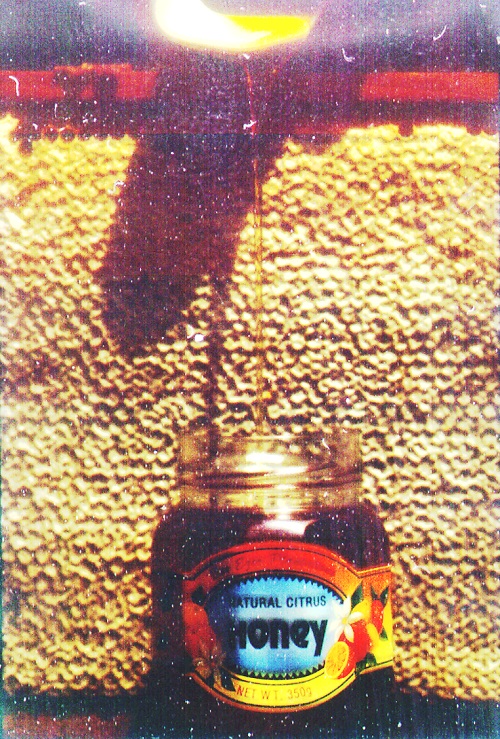
The usefulness of honey bee products for people is based on the same properties that make these products useful for the bees themselves.
We consider the products of social bees; the candidate bees are all honey bees from the genus Apis: Apis mellifera from Europe, Eastern Mediterranean lands and Africa: Apis cerana the hive bee in Asia, and Apis dorsata, Apis florea and related species in the tropics of Asia. In the tropics of all continents there are stingless bees (Meliponinae), some 500 species in all.
Bee products are essential to the bees for their survival and development during and after the evolutionary period: this was and is their function. Stingless bees and honey bees evolved roughly 100 million and 50 million years ago, respectively, whereas people have existed to use the products for only 1 or 2 million years.
The earliest records of people harvesting from bees' nests are in the Mesolithic rock art of Europe and Asia, painted not more than 8000 years ago. There are also rock paintings in Australia showing stingless bee nests. A comprehensive review on the history of the honey bee is given by Crane.[1]
The goal of this review is to examine the chemistry, properties and applications of honey bee products. The recent compre- hensive review of the properties and applications of bee products is the proceedings of the International Conference on : "Bee Products: Properties, Applications and Apitherapy" held in Tel Aviv, Israel, May 1996.[2]
Other highly recommended books on the bee world and bee products are Crane,[3] Ransomel[4] and Graham.[5]
Honey
The most known, discussed and applicable bee product from ancient time till these days is the honey.
Since ancient times many books, stories, tales and symbols, all positive and promising, regarding the characteristics of honey, have been documented in human history.
The earliest known written records of the use of honey by people relate to religious sacrifices in various regions; indeed honey may well have been one of the earliest non-animal sacrifices. It was sometimes offered together with milk, or butter or ghee, oil, or incense.
According to inscriptions on clay cylinders from Sumer in Mesopotamia, when the foundations of a new temple for the god, Ningirsu, were laid about 2500 BC, Gudea the ruler of Lagash made offerings of honey and butter. Then, when the image of the god was finally erected, he offered honey with other foods. The use of honey as an offering probably had a still older origin, because other inscriptions show that it was already customary by Gudea's time.
In Ancient Egypt much honey was sacrificed in religious ceremonies, and when Israelites later presented the first harvest of their produce to God, this included honey.
The earliest recorded medical prescription that includes honey is also from Sumer, dated to about 2000 BC. Oil was to be spread over a preparation of river dust kneaded with honey, water, and other ingredients. This was presumably for external application, and many ancient peoples used honey in this way.[6] In the Ebers papyrus, compiled in Egypt about 1550 BC, honey was found in 147 prescriptions for external use, and in 102 for internal use, both out of a total of several hundreds.
Honey was obtained from bees nesting in rocks, as is usual in a dry country; there is no mention of nests in trees. Honey was also mentioned in many other well-known holy books such as the Koran.
Honey is a supersaturated solution of sugars, mainly fructose, glucose, and maltose-like sugars, with traces of sucrose, glucose oxidase, hydrogen peroxide, phenolics, flavonoids, terpenes, etc.[7] The sugars make honey hygroscopic (moisture absorbing) and viscous, and the sugar concentration plus other factors including low pH, hydrogen peroxide, and the flavonoids, phenolics and terpenes make honey an antimicrobial agent.[8]
Honeys from the nectars of various flowers differ in their colour, taste, smell and in their antimicrobial activities. The main use of honey is as a flavourful sweetener ("The Natural Sweetener") and energy source which is eaten with and as a component of a wide variety of foods. The sweetness is from the sugars, particularly fructose, and flavour is created by a wide variety of trace essences derived from plant esters, alcohols, aldehydes, and other compounds.7 Secondary, but important uses of honey are for the promotion of health and well-being. Some of these uses include aiding in the healing of wounds, healing of serious skin burns, and healing gastric ulcers. The basis for the wound and burn healing properties of honey is its antimicrobial, moisturising/fluid removal, and oxygen barrier properties.
As mentioned before, the application of honey in the healing of wounds and burns has been known from ancient times (see Egyptian documents and books, the Talmud, and the Koran). By keeping a wound or burn clean and moist, and free from bacteria and the damaging effects of oxygen, the wound can heal much more quickly than if left unaided. Modern creams and antibiotics may help heal these types of wounds, but they often have the disadvantages of killing tissue and causing heavy scabs and scars. The healing properties of honey were clearly demonstrated in a study comparing honey treatment to that of silver sulfadiazine, the standard treatment, for burn victims. The results of the study (Table 1) clearly show that honey treatments resulted in a much greater sterility of the wounds, a faster rate of healing, and a faster onset of healing.[9] Similar results have been shown by T. Postmes in tests with burned pigs. In these experiments, honey was shown not only to be better than standard treatments, but also better than artificial honey made from the sugars, but omitting the glucose oxidase, hydrogen peroxide, flavonoids, and other minor components of honey (T. Postmes, personal communication).
|
TABLE 1 [9] |
|||
| Treatment (n=52) | % Sterile in 7 days |
Mean days for granulation |
% Healing in 15 days |
| Honey | 91 | 7.4 | 87 |
| Silver sulfadiazine | 7 | 13.4 | 10 |
As to sweetening food and drinks with honey, it has to be mentioned and emphasised that among populations who use honey or fruit juices as sweeteners, the percentage of people suffering from diabetes is significantly lower than in populations who use white sugar ("The White Killer") or brown sugar ("The Brown Killer") as a sweetener.
One of the best known properties of honey is its anti-microbial activity. This was reported almost a century ago, as stated by Molan in his recent excellent review of the antimicrobial activity of honey.[10]
The following are the factors in honey which contribute to its antimicrobial properties: osmotic effect, acidity (honey pH 3.5–3.9), hydrogen peroxidase (found in honey) and phytochemical factors (found in the flowers' nectar). There are variations in the antimicrobial effect of honey depending on their flower-nectar source, but in general all honeys have this property. The antimicrobial activity of honey is effective against a very wide spectrum of pathogenic bacteria (Gram positive, as well as Gram negative ones), moulds and viruses. Thus, in natural medicine honey is widely used as an antimicrobial agent.
Based on its positive properties honey is widely used in cosmetics. It is a constituent in 30–40% of formulas of various creams used for enriching skin vitality and healing.
Pollen
Bees evolved during the same period as the flowering plants from which they collect nectar and pollen. They pollinate plants by transferring pollen from one flower to another, although this was not understood until Arthur Dobbs in Ireland established it in 1750. Bees also collect pollen and store it in their combs; it supplies them with protein and essential minerals and vitamins.
Pollen collected by beekeepers from honey bee colonies is a product gathered from many, often dozens, of species of plants visited by the bees. This feature enhances the nutritional balance of the pollen, but also means that bee pollen is not a uniform product. Rather it varies somewhat from sample to sample. This variability complicates the analysis of pollen chemistry and requires that statements vis-a-vis pollen be given as averages or as values for a specific species of pollen. All chemical and nutritional analyses here will be given as means derived from large numbers of literature reports that appear reliable.
Table 2 is a listing of the chemical composition of pollen and a comparison of pollen nutrient density with that established for Recommended Daily Allowance (RDA) or Estimated Daily Intake (EDI = Estimated Safe and Adequate Daily Dietary Intakes) for human dietary needs.[11] In general, compared to many standard human foods, pollen is rich in protein, low in fat, and possesses a wealth of minerals and vitamins. No obvious human nutritional deficiencies are present in pollen with the possible exceptions of vitamin B12 and the fat soluble vitamins D and K. In the case of B12 the vitamin is not usually in shortage because the body usually retains a multi-year reserve. Shortage only occurs in cases of defective body recycling (pernicious anaemia) and is particularly needed for pregnant women who have metabolic deficiencies, or are strict vegetarians. Vitamin D is somewhat of a misnomer, as it is not truly a vitamin. Humans can synthesise the vitamin from 7-de-hydrocholesterol if they are exposed to sunlight. Vitamin K is a minor vitamin whose sole role is to aid in blood clotting and which is produced naturally by intestinal bacteria.
Evidence of the digestibility of pollen is provided by Bell et al[12] and Schmidt et al.[13] A testament to its overall balance is demonstrated by mice that survived well for over a year on a diet containing only pollen.[14] Pollen has not been analysed in detail for some of the trace elements such as boron, chromium, molybdenum, iodine, fluoride and selenium, but it would not be surprising if it also contained adequate quantities of these elements.
Pollen has a higher ranking than any comparable foods, even tomatoes and cabbage which are considered to be classic examples of the most nutritious foods available. In terms of protein, pollen is ranked number 2, and above beef. The overall conclusion is that pollen is a food source par excellence that is probably not exceeded by any other food. The one caveat is that pollen is much too expensive to be considered a primary food and, indeed, consumption of large quantities can cause adverse effects. However, this does not preclude pollen from being an excellent food supplement which can enhance the health and well-being of individuals, especially those who otherwise might have an unbalanced diet.
Pollen or pollen products have been shown to have several beneficial applications for human use. Pollen has been successfully used for treatment of some cases of benign prostatitis[18–22] and for oral desensitisation of children who have pollen allergy.[23] Pollen has been shown to be an excellent dietary component in diets for specially or valuable animals (see 16 for more discussion).
A comprehensive review on pollen composition, properties and applications was published in 1997 by Campos et al.[24]
Propolis
Propolis is plant resin collected by bees for use in and around the hive. In plants it is usually the sticky coating around buds that serves to protect them from the elements of weather and from attack by bacteria, fungi, moulds and viruses. These are properties that are useful to the bees and are enhanced by the sticky properties of the propolis. Like pollen, propolis is a bee product that cannot be clearly defined and varies from sample to sample. This is a natural outcome of the collection process – propolis collecting bees will use resins from a large variety of trees and other plant species, and these naturally will differ in their qualitative and quantitative chemical composition. Nevertheless, different propolis samples do share considerable similarity in their physical and overall general chemical nature, thereby enabling a general discussion of the properties of propolis.
Much work has been conducted on the chemistry and properties of propolis. Hundreds of chemical compounds have been identified from propolis. The main chemical classes present in propolis are flavonoids, phenolics, and various aromatic compounds. Quercetin, caffeic acid and pinocembrin are typical flavonoid and phenolic compounds found in propolis. These compounds are poorly soluble in water, are usually soluble in alcohols, and are often poorly soluble in hydrocarbon solvents. Propolis also contains some volatile oils, terpenes, pollen and beeswax, but these compounds are not believed to contribute as significantly to the chemical properties and effects of propolis.
As to the major properties and applications of propolis: Propolis is considered to be the natural product which has the highest antimicrobial activity which acts against the widest spectrum of bacteria, fungi and viruses – even more than that of honey. Some people call propolis the "optimal and natural antibiotic". Propolis also has anti-inflammatory effects, tumour cytotoxicity and anaesthetic effects. In Table 3, taken from Schmidt,[15] the pharmaceutical activities of various compounds found in propolis are given.
Royal Jelly
Royal jelly is a creamy product secreted by young nurse worker bees for feeding to the queen, queen larvae, and other young larvae. It is totally synthesised by the bees in the hypopharyngeal and mandibular glands and is derived from the proteins and nutrients in the pollen ingested by the secreting bees. Royal jelly consists of an emulsion of proteins, sugars, and lipids in a water base (Table 4). The proteins have no particularly unusual properties and presumably have the main function of providing the growing larva or the queen with a readily digested source of protein. The remainder of the composition, except the lipids, also appears to be designed towards providing a balance of nutrients. The lipids are unusual because they lack the normal triglycerides and diglycerides typical of insect fats, ie those that are composed of fatty acids having carbon chains of even numbers from 14 to 20. Instead royal jelly lipids are composed mostly of short chained 8–10 carbon hydroxy fatty acids or diacids. These compounds have active functionalities at both ends of the molecule, are more soluble in water than usual fatty acids, are highly acidic, and act as good detergents and antimicrobial agents. It is the antimicrobial activity, that appears to be the main function of the lipids in royal jelly.
For humans, royal jelly possesses the appealing properties of being a creamy emulsion that is strongly antibacterial. These make it an ideal component of cosmetics and skin care products. Internal uses of royal jelly are less promising, as all the antibacterial activities disappear when the pH is above 6. The natural buffering systems in the body maintain a pH of about 7.4. In fact, no clear evidence from controlled experiments exists to support claims of internal usefulness of royal jelly; that in conjunction with the lack of a theoretical chemical basis for activity leads to the conclusion that there is little future promise for pharmaceutical use of royal jelly. Royal jelly is a highly nutritious specialised food product.
Bee Venom
Bee venom is synthesised by honey bees for only one purpose, as a defensive agent against predators, primarily large mammalian and other vertebrate predators. In order to be of defensive value the venom must induce pain, cause damage, or have some other pharmacological or sensory activity in the potential predator. Bee venom, unlike many other insect allomones, or chemical defences, is water soluble, not fat soluble, and must be injected or applied to moist tissues to be active. This water solubility is an advantage as it allows a whole new suite of highly active defensive compounds to be used. Bee venom is composed of a diversity of proteins, peptides, active amines, and other compounds which posses a variety of activities. The major chemical components and their primary activities are listed in Table 5. The main pain-inducing and lethal component appears to be melittin and this component might be responsible for much of the activity of bee venom in apitherapy use.
People used bee venom primarily for apitherapy to treat a variety of auto immune diseases, with recent usage for immunotherapy of bee sting allergic patients. Bee venom therapy (BVT) has been particularly successful with individuals suffering from rheumatoid arthritis, gout, and multiple sclerosis. Also a variety of other immune disorders including scleroderma and asthma have been treated. BVT is one of the major apitherapy concepts of using bee products for curing human diseases. A comprehensive review on bee venom therapy was published in 1997 by Cherbuliez.[25]
Beeswax
Beeswax is synthesised de novo by honey bees in four pairs of glands located on the ventral side of the abdomen. Bees use the wax as their primary building material for making combs for rearing their brood and for storage of honey and pollen. Beeswax is composed of a variety of monoesters, diesters, hydroxylated esters, hydrocarbons, and free fatty acids (Table 6). This composition distinguishes the material as a wax rather than a fat because it is composed mostly of esters and long chained hyrocarbons, classic wax components. Triglycerides and diglycerides, typical of fats, are missing.
Beeswax was used in early civilisations to cast copper and later other metals from an original wax model into superb objects of art, by the lost-wax process.
In the Batik cloth painting technique, beeswax is one of the key components.
Beeswax candles have been used for lighting since ancient Egyptian times.
Beeswax is an important ingredient in ancient and modern cosmetic products.
Coating and preservation of various products (eg cheeses, toys etc.) is done by beeswax.
In apitherapy, inhalation of beeswax is used to treat upper respiratory disorders.
Conclusions
Bee products are a group of natural products. Although intended for the use of the bees themselves, human beings have successfully used bee products for their own benefit in a wide spectrum of applications. This is a clear-cut proof that in nature we can find all that we need for our life, health and treatment of illness.
References
1. Crane, E. The Archaeology of Beekeeping. Cornell University Press, Ithaca NY, USA 1983.
2. Mizrahi, A. and Lensky, Y. Bee Products: Properties, Applications and Apitherapy, Plenum, London, UK 1997.
3. Crane, E. Bees and Beekeeping. Cornell University Press, Ithaca NY, USA 1990.
4. Ransome, H.M. The Sacred Bee, Bee Books New & Old, Burrowridge, Bridgwater, Somerset, UK 1986.
5. Graham J.M.: The Hive and the Honey Bee. Dadant and Sons Publications, Hamilton IL, USA 1993.
6. Manjo, G. The Healing Hand, Man and Wound in the Ancient World. Harvard University Press, Cambridge MA, USA 1975.
7. White, J.W. Jr. Composition of Honey. In: Honey – A Comprehensive Survey (Crane, E. Editor). Heinemann, London UK 1975. pp. 157–206.
8. Molan, P.C. (1992) The Antibacterial Activities of Honey. The Nature of the Antibacterial Activity. Bee World 73, 5–28.
9. Subrachmanyam, M. (1991) Topical Application of Honey in Treatment of Burns. Brit. J. Surg. 78, 497–498.
10. Molan, P.C., Honey as an Antimicrobial Agent in: Bee Products: Properties, Applications and Apitherapy. (Mizrahi, A. and Lensky, Y.
Editors) Plenum London UK 1997, pp. 27–37.
11. Recommended Dietary Allowances, 10th Edition. National Academy Press, Washington, DC 1989.
12. Bell, R.R., Thornber E.J., Seet J.L.L., Groves M.T., Ho N.R. and Bell D.T. (1983) Composition and Protein Quality of Honeybee-Collected Pollen of
Eucalyptus Calophlla, J. Nutr. 113, 2479–2484.
13. Schmidt, P.J., Schmidt, J.0. and Weber, C.W. (1984) Mesquite Pollen as a Dietary Protein Source for Mice. Nutr. Reports Intl. 30, 513–22.
14. Liebelt, R.A., Lyle, D. and Walker, J. (1994) Effects of a Bee Pollen Diet on Survival and Growth of Inbred Strains of Mice. Am. Bee J. 134,
615–620.
15. Schmidt J.O., Bee Products, Chemical Composition and Application. In: Bee Products Properties, Applications and Apitherapy (Mizrahi, A.
and Lensky, Y. Editors) Plenum London UK, 1997. pp. 15–26.
16. Schmidt, J.0. and Buchmann, S.L. Other Products of the Hive, in: The Hive and the Honey Bee (Graharn, J.M. Editor) Dadant and Sons,
Hamilton, IL. 1992. pp. 927–988.
17. Atwater, W.0. (1910) Principles of Nutrition and Nutritive Values of Food. U.S. Dept. Agric. Bull. 142 (Second review).
18. Denis, L.J. (1966). Chronic Prostatitis. Acta Urol. Belg. 34, 49–55.
19. Ask–Upmark, E. (1967). Prostatitis and its Treatment. Acta Med. Scand. 181, 355–357.
20. Hayashi, A.U., Mitsui, J. and Yamakawas H. (1986). Clinical Evaluation of Cernilton in Benign Prostatic Hypertrophy. Hinyokika Kiyo 32,
135–141.
21. Samochowiec, L., Dutkiewicz, T., Wojcicki J. and Gieldanowski, J. (1992) The Influence of Pollen Extracts (Cernitin GBX and Cernitin T60) on Allergic Reactions. Phytother. Res. 6, 314–317.
22. Rugendorff, E.W., Weidner, W., Ebeling L. and Buck A.C. (1993) Results of Treatment with Pollen Extract (Cernilton N) in Chronic Prostatitis and
Prostatodynia. Brit. J. Urology 71, 433–438.
23. Wortmann, F. Oral Immunotherapy, in: Clinical immunology and Allergology. (Steffen, C. and H. Ludwig Editors) Elsevier/North-Holland,
Amsterdam. 1981. pp. 389–398.
24. Campos, M.G., Cunha, A., and Markham, K.R.: Bee-Pollen – Composition, Properties and Applications in: Bee Products – properties,
Applications and Apitherapy (Mizrahi, A. and Lensky, Y. Editors), Plenum London UK. 1997 pp. 93–100.
25. Cherbuliez, Th. Bee Venom in Treatment of Chronic Diseases. In: Bee Products: Properties, Applications and Apitherapy (Mizrahi, A. and Lensky, Y. Editors) Plenum, London, UK 1997, pp. 213–220.
Comments:
-
No Article Comments available
